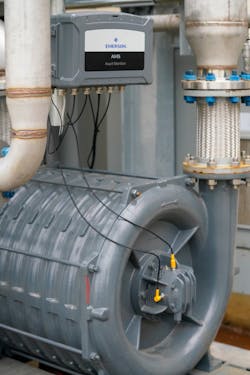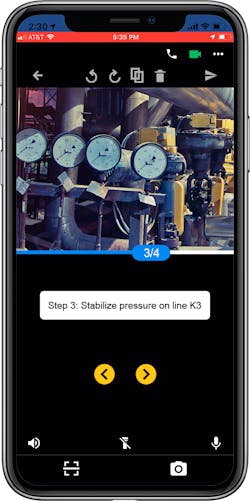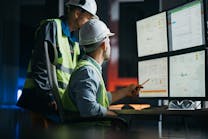Deploying remote monitoring to deliver long-term operational success
In the last 12 months, remote monitoring has moved from contributing to operational success to a requirement for business continuity. Organizations are using remote monitoring during the COVID-19 pandemic to allow technicians and third-party experts to view asset health and performance from outside the plant, and to support project execution and ensure social distancing when possible.
Remote tools such as virtual factory acceptance tests, mobile apps, cloud engineering and virtual support are becoming the norm as all industries need to continue projects and maintain operations. Changing global conditions and a generational shift in the workforce will only increase the need for remote monitoring in the months and years ahead.
When organizations implement remote monitoring, immediate need often necessitates a fast deployment and short-term results. Consequently, many plants follow a bottom-up approach, solving immediate needs with standalone monitoring solutions. But there is a better approach to deliver short-term results and long-term benefits.
Designing remote systems for today and the future
The bottom-up approach takes advantage of remote monitoring at the device or asset level to monitor individual assets in the plant and deliver fast return on investment. It often incorporates edge analytics to improve reliability and decision support on the plant floor and in the field.
However, remote monitoring is about access to data. While plants want to quickly deliver data across the operational technology environment, securely pushing data to the enterprise level allows assessment of how plant reliability impacts total production across the organization. Higher-level data mobility requires a top-down approach to remote monitoring design to push plant data into enterprise systems and data lakes for high-level analysis.
A difference in deployment approach does not need to be a barrier to operational excellence. By choosing scalable solutions designed to be integrated into a holistic remote monitoring system, organizations can circumvent the need to choose a top-down or bottom-up solution for the entire organization.
Instead, they can design remote solutions that meet in the middle to provide the plant-level visibility they need today while preparing for the enterprise-wide visibility and analytics required to drive better business decisions tomorrow.
Today’s solutions lay a foundation
Plant personnel need access to the high-quality data available across the plant to make the best decisions. This need is compounded when personnel are working remotely — from home or a distant facility.
Unexpectedly offsite
Field technicians and vibration experts in facilities such as chemical processing plants need to keep a close eye on the condition of essential assets such as pumps, compressors, fans and heat exchangers, even when these personnel are working outside the plant. The longer an asset goes unmonitored, the more likely a defect will go undetected and result in an unexpected failure, often with a significant negative impact on production, quality and efficiency. And when fewer people are in the plant to respond to an unexpected failure, it becomes even more important to enable remote technicians to identify problems quickly and easily.
The need for critical personnel to respond quickly from offsite is often unanticipated. Social distancing guidelines, extreme weather events and all-hands-on-deck operations at facilities can leave plant personnel with short notice to implement remote monitoring. These immediate needs typically do not allow reliability teams the time to develop a top-down solution.
However, making the right choice for a standalone solution can facilitate easier operations today and fast integration to enterprise systems in the future. The key to a successful bottom-up solution is to design with the “up” in mind.
Choosing scalable solutions
Organizations facing an immediate need for remote access solutions have more choices than ever for providing remote monitoring to personnel. The simplest of these solutions provide raw data that users can analyze to extrapolate the health of their equipment. However, newer, more robust solutions not only provide raw data, but also incorporate edge analytics — often performed at the device itself — and improved user interfaces to help personnel quickly and easily extract value from the collected data. This data is provided in a format immediately useful to technicians, but it is also ready to be incorporated into other plant-wide and enterprise-wide systems.
One key example is bearing analysis. If a remote technician only receives raw data from a device, it is possible spectrum peaks associated with impacting will be lost in the noise of other vibration data — especially when the technician is not on site to also perform visual inspection. The powerful analytics tools available in today’s edge analytics monitors (Figure 1) not only detect these impacting peaks, but also deliver this information to users through intuitive, actionable graphics. Remote technicians receive instant assessments telling them what they need to do, and how fast they need to do it, which they can communicate to on-site personnel when necessary.
The best solutions are also accessible on multiple platforms. Technicians can access information through browser-based web interfaces or through a mobile app. Remote technicians with access to this rich data and actionable advice can make the best decisions with the utmost efficiency, regardless of where they are located.
Scaling up
The best edge analytics solutions are designed to integrate quickly and easily into asset management and industrial internet of things (IIoT) platforms. These platforms extend visibility of plant health across the enterprise with higher-level analytics, trending and easy connection to the cloud and data lakes. Expanded connectivity provides critical health information and performance metrics from one or more facilities to decision makers at company headquarters or to stakeholders across the globe.
Consider a food and beverage manufacturer running multiple plants to meet global demand, while needing to limit the number of personnel onsite at any one location. With the right point solutions in place, a single plant can automatically collect and analyze vibration data and deliver actionable insights to offsite technicians. Those offsite technicians can examine these alerts and determine if on-site personnel need to take action.
The same solution can also be connected to an IIoT platform to deliver data into a data lake, allowing enterprise teams to remotely run analytics on data across sites to develop a higher-level understanding of plant performance (Figure 2).
This increased access to plant data helps enterprise-level analysts identify production bottlenecks and key performance strategies. To reduce risk when pushing data to the enterprise — where systems are typically connected to the internet — such solutions are often designed in collaboration with expert vendors, with a cybersecurity strategy as part of their scalable solution.
Improving remote expert support
Today’s generational shift in personnel means experts at one facility, such as a vibration expert, are often responsible for managing reliability at other plants. Other organizations provide centralized operations for remote facilities via an integrated operations center. In either case, anticipating the need for enterprise-level access to analytics allows the organization to choose point solutions for easy integration into such a system.
For example, a remote expert may have dozens or hundreds of devices in need of monitoring. Collecting data through manual rounds either uses the time of an additional on-site technician or requires the expert to come to site for data collection, in either case resulting in infrequent monitoring.
The best solution for these situations is a small, affordable monitoring device, installable by on-site personnel as needed. Choosing solutions providing insights beyond raw data ensures busy experts serving multiple sites from a remote location can quickly and easily identify problems and direct local plant personnel to solutions. Moreover, the same intuitive data can also be made available to personnel in the plant, allowing them to address simple issues without using the valuable time of a remote expert.
When these standalone solutions are selected with eventual enterprise-level connectivity in mind, they enable a wide array of remote support options. Scalable solutions can be connected to IIoT platforms to enable emerging technologies such as augmented reality (AR), machine learning and more.
Across the enterprise and across the globe
One industrial manufacturer experiencing a personnel shortage needed its small group of experts to serve multiple sites. Standalone solutions sped analysis to some degree, but experts spent too much time traveling, limiting their ability to quickly resolve issues. The organization is now implementing AR technologies powered by an IIoT platform and connected to standalone solutions to enable remote assistance for field operators and technicians (Figure 3).
Fortunately, the organization originally chose point solutions designed to be easily integrated into enterprise IIoT systems. Now, those same experts can use the AR functionality in their IIoT platform to connect field technicians and remote experts to device-level data, and both groups can see exactly what’s happening.
Remote experts can explain processes, procedures and repairs, all while illustrating key steps through annotations on the field user’s screen — all of which is overlaid on the plant environment. Any work performed or information created can also be saved in a log for training and review to speed resolution of future recurring problems.
The same process can be used with third-party subject matter experts, who can leverage cloud and IIoT platforms to deliver in-person service from a remote location. No matter how remote the asset, expert assistance is always available, without the cost and delay of sending an expert to the field.
Upward momentum
Industrial operations are changing fast, and remote monitoring is no exception. The best way to stay ahead of change is to implement point solutions capable of evolving toward a more connected future. By selecting solutions designed to provide insights instead of raw data — and most importantly to easily scale and integrate — organizations empower personnel with the tools they need to improve reliability, while laying the foundation for significant long-term improvements in operational excellence.
Mani Nambiar leads product management for Emerson’s operational certainty solutions portfolio in the digital transformation business. Nambiar is focused on driving product direction to help customers improve their safety, reliability, energy and performance management. He has over 22 years of experience in the process control industry. Nambiar holds a Bachelor of Engineering degree in instrumentation and control from the National Institute of Technology in India and a Professional MBA degree from the University of Tennessee.





